ISSN ONLINE(2319-8753)PRINT(2347-6710)
ISSN ONLINE(2319-8753)PRINT(2347-6710)
Raghavendra S Muttalli1, Shweta Agrawal2, Harshla Warudkar3
|
| Related article at Pubmed, Scholar Google |
Visit for more related articles at International Journal of Innovative Research in Science, Engineering and Technology
Centrifugal pumps are a most commonly used in different fields like industries, agriculture and domestic applications. Computational Fluid Dynamics is most commonly used tool for simulation and analysis. 3-D numerical CFD tool is used for simulation of the flow field characteristics inside the turbo machinery. CFD simulation makes it possible to visualize the flow condition inside centrifugal pump. The present paper describes the head, power, efficiency and to evaluate the pump performance using the ANSYS CFX-14, a computational fluid dynamics simulation tool. These simulations of centrifugal pumps are strongly related to cavitation flow phenomena, which may occur in either the rotating runner-impeller or the stationary parts of the centrifugal pumps. The numerical simulation can be used to detect the cavitation in centrifugal pump and to get safe range of operating at different flow rate and rotating speed
Keywords |
| Centrifugal pump impeller, CFD, Head, Power, Efficiency, Cavitation. |
I. INTRODUCTION |
| Centrifugal pump is a type of a turbo machine in which mechanical energy is converted into pressure energy by means of centrifugal force acting on the fluid. It is classified as rotor dynamic type of pump in which dynamic pressure is developed which enables the lifting of liquids from lower level to higher level. Since lifting of liquid is due to centrifugal action, it is called as centrifugal pump. Centrifugal pump has high output and high efficiency compared to other types of pumps. To develop a consistent machine for high demand operations, before they are put in actual use the performance of the flow in the entire pump has to be predicted. This requires critical analysis of highly complex flow in the pump which is turbulent and three dimensional in nature. CFD simulation makes it possible to visualize the flow condition inside a centrifugal pump, and provides valuable information about the centrifugal pumps hydraulic design. Simulation result is used to calculate or predict the performance of a centrifugal pump to replace or reduce the experiments in the process of pump design. A great deal of labour and facility will be saved, as well as it helps in shortening the design cycle. Therefore, great improvement on centrifugal pump design must be achieved by CFD analysis of inner flow inside a centrifugal pump and following application of its results in pump design processes. |
| Many researchers have used CFD for the numerical simulation of centrifugal pumps. S Rajendran and Dr.K Purushothaman [1] carried out a centrifugal pump impeller analysis using ANSYS-CFX and predicted the flow pattern, pressure distribution in the blade passage, blade loading and pressure plots. S R Shah, S V Jain and V J Lakhera [2] carried out analysis of centrifugal pump and the non-uniformities in different parts of the pump at off-design conditions which result in the decrease in efficiency. P.Usha Shri and C.Syamsundar [3] contributed to reveal the simulation of the flow in a centrifugal pump impeller at five different flow coefficients viz. 0.0146, 0.0346, 0.0546 (designed flow coefficient), 0.0746 and 0.0946. E.C. Bacharoudis, A.E. Filios, M.D. Mentzos and D.P. Margaris [4] have contributed to reveal the flow mechanisms inside centrifugal impellers and studied performance by varying outlet blade angle. They observed a gain in head more than 7 % with increase in outlet blade angle from 20o to 45o. Marco Antonio Rodrigues Cunh and Helcio Francisco Villa Nova [5] have carried out cavitation modelling of a centrifugal pump and predicted cavitation places looking for the pressure field, since the it has a direct relation with the vapour pressure at the flow fluid temperature, becoming possible to add improvements in the project of the equipment in order to prevent or to minimize the phenomenon. The present paper is concerned with the head, power, efficiency, cavitation and to evaluate the pump performance using the ANSYS CFX. |
II. PROBLEM STATEMENT |
| Head, power, efficiency and cavitation of the centrifugal pump are taken as the focus area of this paper. Head is linked to the pressure. If you point the discharge of a centrifugal pump straight up into the air, it will pump the fluid to a certain height called the head. This maximum head is mainly determined by the outside diameter of the pump's impeller and the speed of the rotating shaft. The head will change as the capacity of the pump is altered. The shaft power of a pump is the mechanical power transmitted to it by the motor shaft, while fluid power is the energy per second carried in the fluid in the form of pressure and kinetic energy. The efficiency is the ratio of output power to input power. Because of friction and internal leakage, the power input to a pump is larger than the fluid power. Cavitation is the formation and subsequent collapse or implosion of vapor bubbles in a pump. It occurs when the absolute pressure on the liquid falls below the liquid’s vapor pressure. If the vapor bubbles collapse with high enough energy, they can remove metal from the internal casing wall, and leave indent marks. More commonly, the pump efficiency will decrease significantly during cavitation and continue to decrease as damage to the impeller increases. It is important to recognize the detection and prevention of cavitation. |
III. MESHING |
| In current paper the geometry and the mesh of a ten bladed pump impeller domain were generated with Ansys Workbench. Unstructured meshes with tetrahedral cells are used for the domain of impeller as shown in Figure 1. |
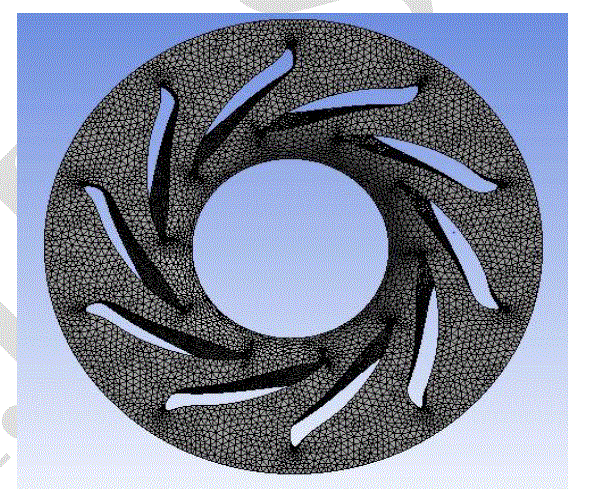 |
 |
| Mesh details of centrifugal pump impeller is shown in Table 1. Pump impeller shown in figure contains totally 54375 nodes and 266745 tetrahedral elements. |
IV. SIMULATION OF CENTRIFUGAL PUMP |
| After meshing of the model of pump assembly commercial CFD code CFX-14 is used for simulation of the pump performance. The boundary conditions are applied. The performance results are obtained at different mass flow rate conditions with different operating speed by taking turbulent modeling. The numerical simulation is checked to detect the cavitation in centrifugal pump and to get safe range of operating at different flow rate and operating speed. |
| 4.1 Assumptions |
| The simulation of flow inside the centrifugal pump is done on basis of following basic assumptions: |
| Steady state condition. |
| Constant fluid properties. |
| Incompressible fluid flow. |
| The walls were assumed to be smooth hence any disturbances in flow due to roughness of the surface were neglected. |
| 4.2 Boundary conditions |
| Boundary conditions are the set of conditions specified for the behavior of the solution to a set of differential equations at the boundary of its domain. Mathematical solutions are determined with the help of boundary conditions to many physical problems. These conditions specify the flow and thermal variables on the boundaries of a physical model. |
| The pump has various components like inlet, outlet, blades, hub and shroud. The pump inlet was defined as total pressure boundary condition and mass flow rate outlet was given at the pump outlet. The other surfaces were given as wall boundary conditions. Rotating faces of impeller considered as wall and no slip wall condition is applied. At fluid wall interface, there must be no slip. Operating temperature is specified at the inlet. |
| 4.3 Solution parameters |
| Solution parameter is very important in solving any CFD problem. Advection scheme high resolution technique is used to simulate the pump performance. Turbulence numeric’s is first order. The standard k-ε model is used for turbulence modelling with standard wall function. The standard k- ε model is a semi-empirical model based on model transport equations for the turbulence kinetic energy (k) and its dissipation rate (ε). Convergence criteria for mass, momentum and turbulence parameters were set to 10-4. Mixture of water and Ethylene glycol is taken as working fluid, with the vapour pressure 50000 Pa. Number of iteration used for the simulation of centrifugal pump analysis are 10000. |
V. PERFORMANCE CHARACTERISTICS OF PUMP |
| The performance characteristic of the centrifugal pump has been predicted numerically handling clear Water- Ethylene glycol mixture as working fluid. Head, power and efficiency characteristics of the pump are predicted by CFD analysis at 7000rpm, 7700rpm, 8400rpm and 9100rpm explained graphically in figures. CFD analysis is done at a mass flow rate 40 lpm, 60 lpm, 80 lpm, 100 lpm, 120 lpm, 150 lpm, 170 lpm and 220 lpm. |
 |
| Figure 2 shows head characteristics curve generated at different rotating speed with increase in discharge. As, the speed of the pump was kept constant it can be observed that as discharge increases head decreases. We obtained maximum head at 9100rpm and minimum head with 7000rpm. The shape of the curve varies with pump’s specific speed. From graph it is clear, the head is function of rotating speed. High head can be obtained with higher rotating speed. The nature of head versus discharge curve is similar to that of standard pump curve. |
 |
| The input power is considered as the mechanical power supplied by the motor at the pump shaft. Figure 3 shows variation of input power at the pump shaft with increase in discharge for various rotating speed. To plot this curve, the speed of the pump was kept constant and variation of shaft power input was plotted correspond to increase in discharge. It can be seen that as discharge increases the power input for the pump increases. The nature of power versus discharge curve is similar to that of standard pump curve. |
 |
| Figure 4 shows variation of pump efficiency with increase in discharge for various rotating speed. As, the speed of the pump was kept constant it can be observed that as discharge increases, the efficiency increases, reaches maximum at rated conditions and then decreases when discharge increases beyond rated conditions, parabolic profile. The nature of efficiency versus discharge curve is similar to that of standard pump curve. |
| 5.4 Cavitation analysis |
| Cavitation causes loss of performance and degradation of life in the centrifugal pumps. Hence the analysis of cavitation is a very important aspect of any centrifugal pump. With the use of CFD tools it is possible to have a forecast about the cavitation places looking for the pressure field, since the cavitation has a direct relation with the vapor pressure at the flow fluid temperature, becoming possible to add improvements in the project of the equipment in order to prevent or to minimize the phenomenon, without the use of experimental methods that in the most cases showing high cost. With the CFD tools it is much easier to detect the cavitation occurring at different parts of the centrifugal pump and to get safe range of operating at different flow rate and rotating speed. |
| 7000rpm |
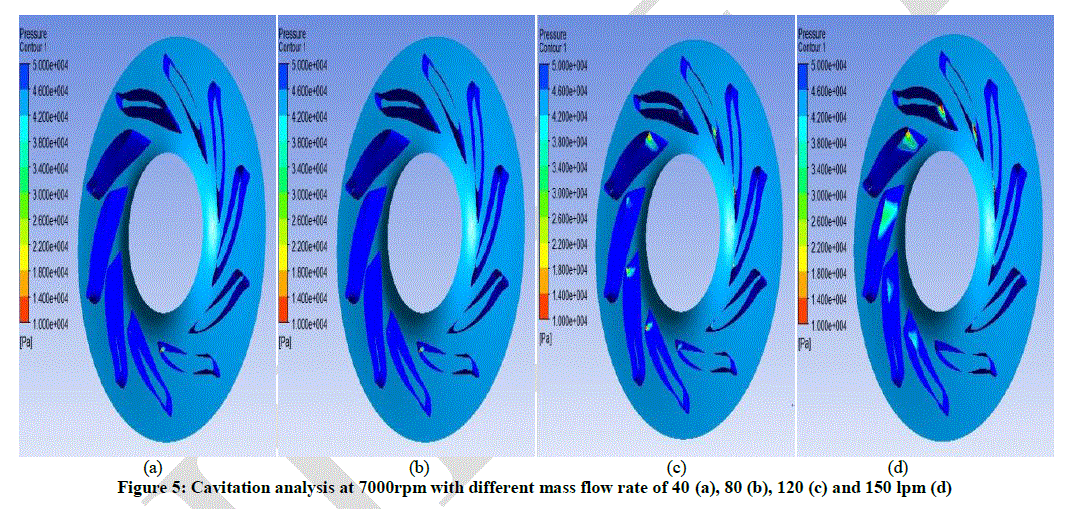 |
| Figure 5 shows the cavitation analysis of an impeller model at constant 7000rpm with the mass flow rate of 40 (a), 80 (b), 120 (c) and 150 lpm (d). We observed cavitation free operation at 40, 80 and 120 lpm. The formation of cavitation on the blades can be seen from 150 lpm running at 7000rpm. |
| 7700rpm |
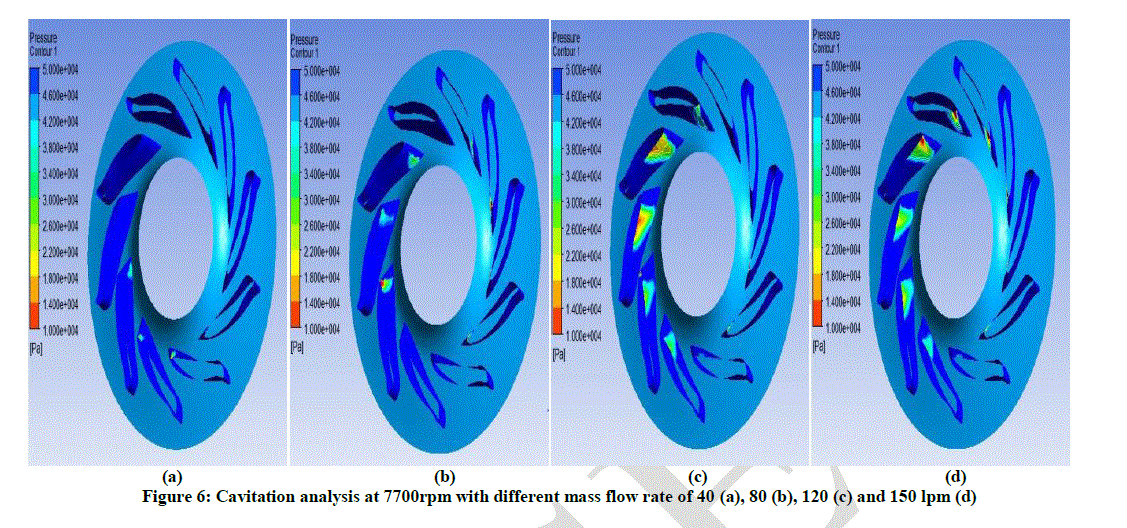 |
| Figure 6 shows the cavitation analysis of an impeller model at constant 7700rpm with the mass flow rate of 40 (a), 80 (b), 120 (c) and 150 lpm (d). We observed cavitation free operation at 40 and 80 lpm. The formation of cavitation on the blades can be seen from 120 lpm running at 7700rpm |
| 8400rpm |
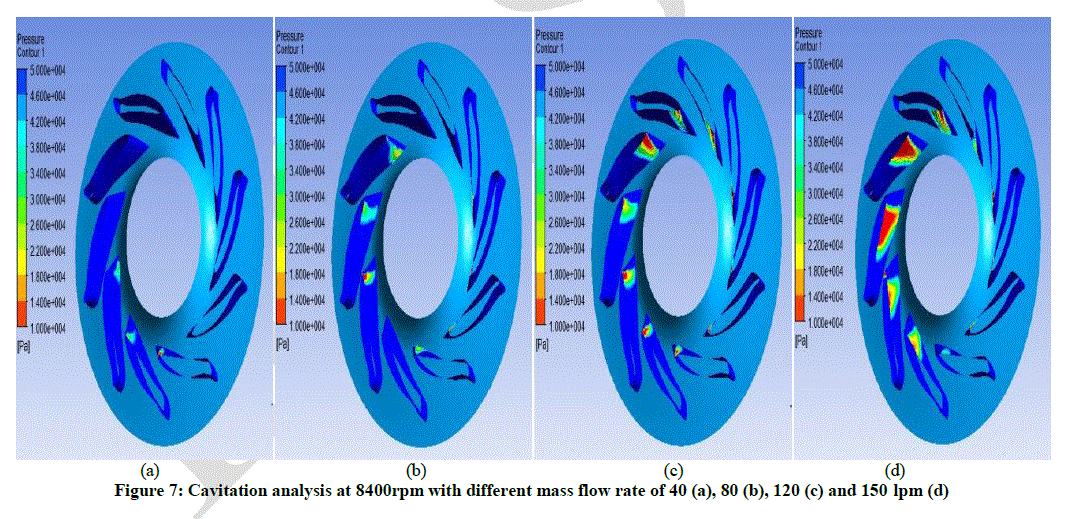 |
| Figure 7 shows the cavitation analysis of an impeller model at constant 8400rpm with the mass flow rate of 40 (a), 80 (b), 120 (c) and 150 lpm (d). We observed cavitation free operation at 40 and 80 lpm. The formation of cavitation on the blades can be seen from 120 lpm running at 8400rpm. |
| 9100rpm |
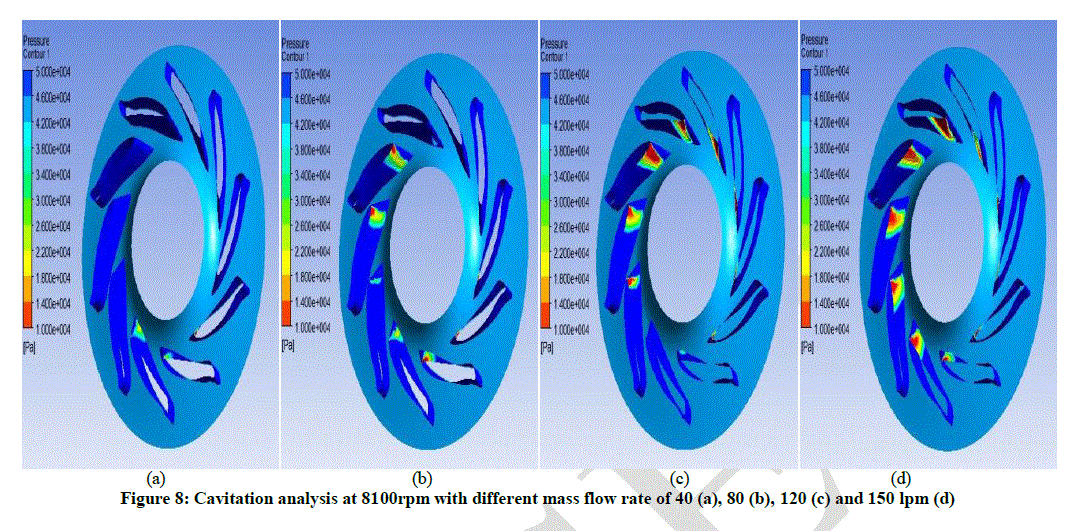 |
| Figure 8 shows the cavitation analysis of an impeller model at constant 9100rpm with the mass flow rate of 40 (a), 80 (b), 120 (c) and 150 lpm (d). We observed cavitation free operation at 40 lpm. The formation of cavitation on the blades can be seen from 80 lpm running at 9100rpm. |
| Figure 5, 6, 7 and 8 shows the cavitation analysis of centrifugal pump at 7000, 7700, 8400 and 9100 rpm with mass flow rate 40 (a), 80 (b), 120 (c) and 150 lpm (d). This can be done in post processing by measuring the pressure lower that the vapour pressure. The vapour pressure of used fluid is 50000 Pa. The colour other than blue shows the drop of pressure and reaching the vapor pressure on the impeller blades. This forms the cavitation and affects the performance of the centrifugal pump and it is noted from all the above analysis that, cavitation is increasing with the increase of mass flow rate and rotating speed. This analysis will helps in to get safe range of operating at different flow rate and rotating speed. |
| 5.5 Pressure contours |
| The properties of internal flow of the centrifugal pump can be analyzed by using pressure contours. Study of the pressure contours help in understanding of energy conversion taking place in different parts of the pump. The static pressure contours are varying with span. Static pressure on pressure side is more compared to suction side. The static pressure contours are varying with span. Because of flow transition from the axial to the radial, pressures near the hub are higher than shroud. |
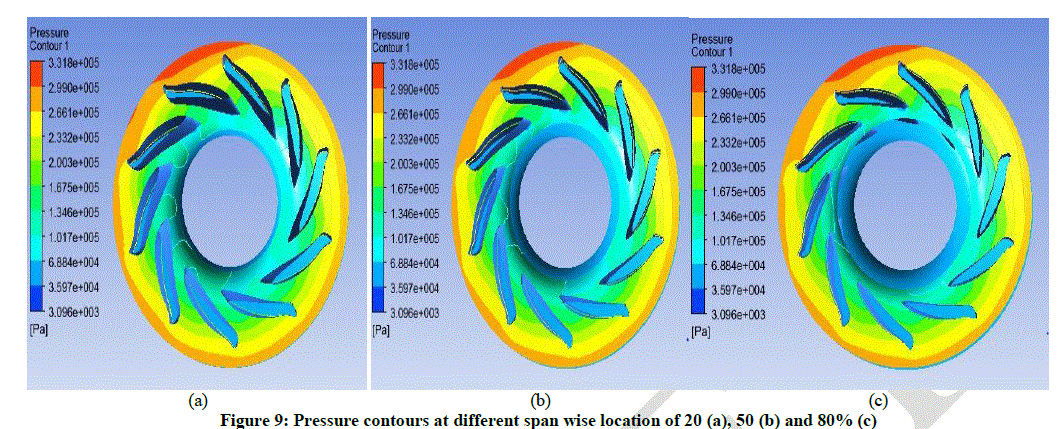 |
| Figure 9 shows the pressure contours of designed model at a span of 20 (a), 50 (b) and 80% (c). It is seen that the pressure continuously increases from leading edge to trailing edge of the impeller as the mechanical energy imparted in the form of impeller rotation is converted into the pressure energy. It can be seen that the pressure variation is uniform. |
| 5.6 Velocity vector contours |
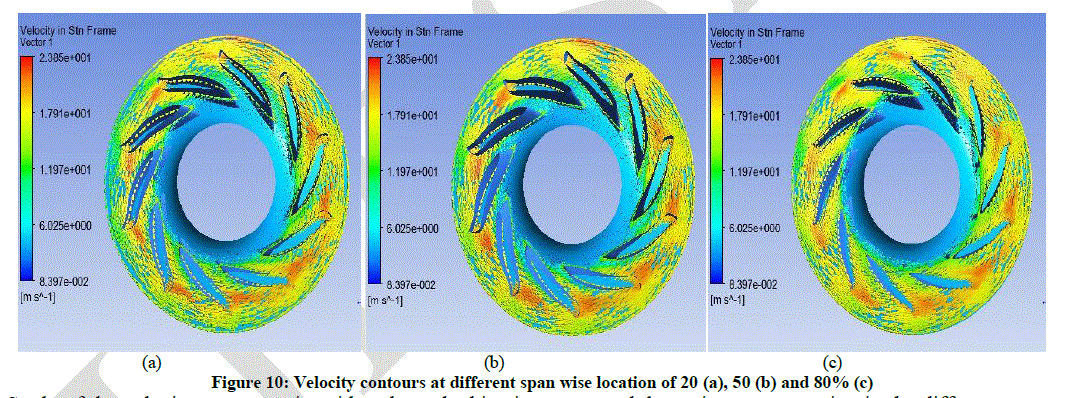 |
| Study of the velocity contours gives idea about the kinetic energy and dynamic pressure acting in the different parts. Study of velocity vectors helps in identifying the direction of fluid particles flowing through the different components . Figure 10 shows the velocity vector contours of designed model at a span of 20 (a), 50 (b) and 80% (c). The velocity continuously increases as the mechanical energy is converted into the kinetic energy. |
VI. CONCLUSION |
| The flow through a centrifugal pump was analyzed using commercial CFD package ANSYS-CFX. CFD analysis was carried out at design and off design condition and is reported. The simulation results are obtained at the operating speed 7000, 7700, 8400, 9100 rpm with different mass flow rates for transportation of fluid. The Simulation was performed by using turbulent modeling k-Epsilon. Performance charts, cavitation analysis, pressure contours and velocity vector contour are predicted. |
| The mesh is generated successfully using ANSYS-CFX. The performance results are satisfactorily matching with test data, hence mesh quality is good. |
| The increase of the designed flow rate causes a reduction in the total head of the pump. |
| Near leading edge of the blade low pressure is observed. |
| Almost similar trends were observed when the operating characteristic curves predicted by CFD were compared with the model test results. |
| The performance results show that total static head is the function of the mass flow rate with constant operating speed. |
| The model is free from cavitation at design point and it is also noted that, the formation of cavitation on the blade is increasing with the increase of mass flow rate and rotating speed |
References |
|